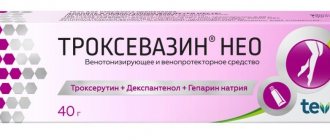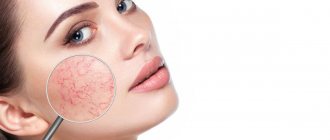What is Troxevasin
A medicine based on the angioprotective active substance troxerutin. Regulates the tone of capillary vessels and veins. It is used to eliminate pain, swelling and trophic disorders caused by their dysfunction.
Troxevasin is produced:
- in the form of an ointment for topical use: a viscous yellowish gel-like mass containing 2% troxerutin, packaged in 40 g tubes;
- in the form of capsules for oral administration: in a dosage of 300 mg of the active substance, gelatin, in blisters.
The product has a pronounced venoprotective effect. It helps reduce the permeability of vascular walls, improves blood outflow, prevents its stagnation in the lower extremities, prevents thrombus formation and the development of inflammatory processes. Troxevasin alleviates the underlying symptoms of varicose veins and slows down its progress.
Therapeutic effects, pharmacodynamics and pharmacokinetics
Types of effects Troxevasin has on veins and capillaries:
- tonic;
- tread.
The drug reduces the size of the pores between the cells of the endothelial layer of blood vessels, makes red blood cells more elastic, and also reduces their aggregation.
In chronic venous insufficiency, Troxevasin reduces the manifestations of trophic disorders, such as swelling, pain, and cramps. The drug also helps relieve symptoms of hemorrhoids, eliminating itching in the anal area and bleeding.
A positive effect on the walls of capillary vessels and the rheological properties of blood helps to slow down the development of retinopathy, which is observed in diabetes mellitus.
The contents of the capsules are absorbed in the intestines by only 10-15%. The maximum concentration is reached 120 minutes after taking the medication. It is mainly excreted through the intestines, partly by the kidneys.
What is Troxevasin used for?
Medicinal ointment and capsules are prescribed:
- for chronic venous insufficiency;
- lack of nutrition of soft tissues caused by varicose veins;
- with postphlebitic syndrome;
- trophic ulcers;
- for symptoms of hemorrhoids;
- with retinopathy against the background of hypertension and diabetes.
The drug is used to prevent complications after surgical treatment of varicose veins, to prevent further vascular damage in the initial stages of pathology. Troxevasin is also indicated to improve well-being after mechanical injuries: bruises or sprains.
The active substance from the capsules is absorbed in the intestines. Its maximum concentration in the blood is observed 1.5–2 hours after administration. Metabolized by the liver and completely leaves the body within 0.5–1 day. Troxerutin from the ointment penetrates all layers of the epidermis, dermis and subcutaneous tissue within 3–5 hours.
Troxevasin capsules 300 mg No. 100
Compound
Active substance: troxerutin 300 mg.
Excipients: lactose monohydrate - 47 mg, magnesium stearate - 3 mg. Shell composition: quinoline yellow dye (E104) - 0.9%, sunset yellow dye (E110) - 0.039%, titanium dioxide (E171) - 3%, gelatin - up to 100%.
Pharmacokinetics
Absorption After oral administration, absorption is about 10-15%. Cmax in blood plasma is achieved on average 2 hours after administration, the therapeutic level in plasma remains for 8 hours.
Metabolism and excretion Metabolized in the liver. Partially excreted unchanged in urine (20-22%) and bile (60-70%).
Indications for use
- Chronic venous insufficiency;
- postphlebitic syndrome;
- trophic disorders in varicose veins;
- trophic ulcers;
- as an auxiliary treatment after sclerotherapy of veins and removal of varicose veins;
- hemorrhoids (pain, exudation, itching, bleeding);
- venous insufficiency and hemorrhoids during pregnancy, starting from the second trimester;
- as an auxiliary treatment of retinopathy in patients with diabetes mellitus, arterial hypertension and atherosclerosis.
Contraindications
- Hypersensitivity to rutosides or other components of the drug.
- Pregnancy (1st trimester).
- Peptic ulcer of the stomach and duodenum.
- Chronic gastritis in the acute phase.
- Children under 18 years of age (experience of clinical use is insufficient).
- Breastfeeding period.
- Rare hereditary galactose intolerance, lactase deficiency, glucose-galactose malabsorption syndrome.
Carefully:
- For renal failure (with long-term use).
- Pregnancy (II and III trimesters).
Directions for use and doses
The drug is taken orally with meals. Capsules should be swallowed whole with plenty of water.
At the beginning of treatment, 300 mg (1 capsule) is prescribed 3 times a day. The effect usually develops within 2 weeks, after which treatment is continued at the same dose or reduced to the minimum maintenance dose of 600 mg, or suspended (the achieved effect persists for at least 4 weeks). The course of treatment averages 3-4 weeks, the need for longer treatment is determined individually.
For diabetic retinopathy, it is prescribed at a dose of 0.9-1.8 g/day.
Storage conditions
The drug should be stored out of the reach of children, in a dry place, protected from light, at a temperature not exceeding 25°C.
Best before date
5 years. Do not use after the expiration date.
special instructions
When treating superficial thrombophlebitis or deep vein thrombosis, the use of the drug does not exclude the need to prescribe anti-inflammatory and antithrombotic therapy.
Troxerutin is ineffective for edema caused by concomitant diseases of the liver, kidneys and heart.
If during the period of use of the drug the severity of the symptoms of the disease does not decrease or the symptoms of the disease become more severe, you should immediately consult a doctor. There is insufficient experience with the use of the drug in children under 18 years of age. When using the drug independently, you should not exceed the maximum duration and recommended doses.
Description
Venotonic and venoprotective agent.
Use in children
There is insufficient experience with the use of the drug in children under 18 years of age.
Pharmacodynamics
An angioprotective drug that acts primarily on capillaries and veins.
Reduces pores between endothelial cells by modifying the fibrous matrix located between endothelial cells. Inhibits aggregation and increases the degree of deformability of red blood cells; has an anti-inflammatory effect.
In chronic venous insufficiency, Troxevasin® reduces the severity of swelling, pain, cramps, trophic disorders, and varicose ulcers. Relieves symptoms associated with hemorrhoids - pain, itching and bleeding.
Due to its beneficial effect on the permeability and resistance of capillary walls, Troxevasin® helps slow the development of diabetic retinopathy. In addition, its effect on the rheological properties of blood helps prevent microthrombosis of retinal vessels.
Side effects
The incidence of adverse reactions is given in accordance with the WHO classification: very often (≥1/10), often (≥1/100, ˂1/10), infrequently (≥1/1000, ˂1/100), rarely (≥1 /10000, ˂1/1000), very rare (˂1/10000), frequency unknown (cannot be estimated based on available data).
Immune system disorders: very rarely - anaphylactic shock, anaphylactoid reactions, hypersensitivity reactions (for example, skin rash).
Nervous system disorders: very rarely - headache, dizziness.
Vascular disorders: very rarely - hyperemia (“flushes”), ecchymosis.
Gastrointestinal disorders: rarely - nausea, pain and discomfort in the stomach, dyspepsia, flatulence, diarrhea, erosive and ulcerative lesions of the gastrointestinal tract.
Disorders of the skin and subcutaneous tissues: rarely - itching, rash, urticaria.
Other: very rarely - feeling of fatigue.
If undesirable reactions occur, you should consult a doctor.
Use during pregnancy and breastfeeding
The use of the drug during the first trimester of pregnancy is contraindicated. The possibility of using the drug during the second and third trimester of pregnancy is determined by the doctor and is possible only if the expected benefit to the mother outweighs the potential risk to the fetus.
If it is necessary to use the drug in the second and third trimesters of pregnancy, you should consult your doctor.
It is excreted in minimal quantities in breast milk. The use of the drug during breastfeeding has not been studied.
Interaction
The effect is enhanced by simultaneous intake of ascorbic acid.
Overdose
In case of an overdose, the following symptoms may appear: agitation, nausea, headache, flushing of the face.
In case of overdose, patients need to rinse the stomach, take activated charcoal, and, if necessary, begin symptomatic treatment.
Impact on the ability to drive vehicles and operate machinery
Taking the drug does not affect motor and mental reactions, does not interfere with driving and other complex mechanisms.
When is Troxevasin contraindicated?
It is prohibited to take the drug orally:
- with exacerbations of ulcerative lesions of the gastrointestinal mucosa;
- some forms of gastritis;
- severe renal failure;
- increased sensitivity to the active or excipients of the drug.
The use of ointment should be avoided:
- if an allergic reaction to the drug develops: increased swelling, rash, severe burning or itching;
- with severe irritation, furunculosis, open skin lesions at the site of application of the product.
How to use Troxevasin capsules
The medicine should be swallowed with water, without chewing or crushing. Meal times don't matter. At the beginning of therapy, take 1 capsule. three times a day. Diabetic retinopathy and other severe conditions require up to 1800 mg (6 capsules) per day.
The course is continued for up to 15 days. After assessing the effectiveness of the dose, the dose is adjusted. It may increase or decrease. If the symptoms of the pathology subside, at the discretion of the doctor, therapy can be completed without a maintenance period. Otherwise, Troxevasin is taken for another 3-4 weeks.
Instructions for use
How to use capsules:
Patients are prescribed 1 piece three times a day for 3-4 weeks. In the future, it is possible to take a prophylactic dose of 2 capsules per day. The effect after completion of therapy lasts for at least 1 month. For retinopathy accompanying diabetes mellitus, it is possible to increase the dosage to 6 capsules per day. Take the medication during meals with the required amount of clean water.
Method of using the drug in gel form:
Apply Troxevasin externally to intact skin in the morning and evening with light circular movements. This must be done until the product is 100% absorbed. If necessary, elastic stockings are worn over the affected limb. The duration of the course of treatment is determined by the doctor depending on the pathology.
How to use Troxevasin ointment
The drug is used externally: on clean skin over the lesion. A small amount of ointment is distributed over the body area in a thin layer, lightly rubbing it in until completely absorbed. After application, you can leave the skin open or apply fixing bandages, bandages, and put on compression stockings and bandages if necessary.
The procedure for applying the medicine is repeated twice a day: in the morning and in the evening. If this is not enough, do it more often. There is no need to specifically rinse off any remaining drug before applying again. The duration of treatment with ointment is up to 7 days. If there is no result or the physical condition worsens, the medicine is discontinued and another method of therapy is chosen.









